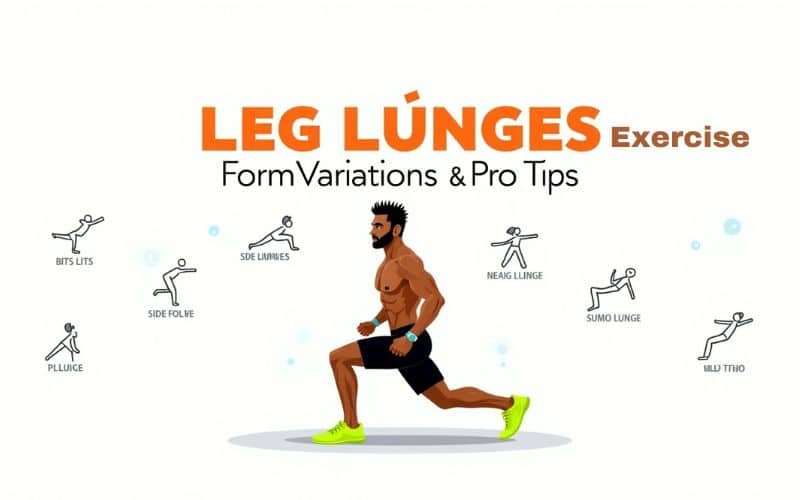Leg Lunges Exercise: Form, Variations & Pro Tips
Introduction
Leg lunges are a time-honored exercise that delivers unparalleled results. Simple yet highly effective, lunges target the lower body while engaging the core. With every stride forward or backward, lunges demand balance, coordination, and strength—making them a full-package movement.
Unlike machine-based exercises, lunges mimic natural movements you perform daily. Walking, climbing stairs, or even bending down becomes easier and more controlled when lunges are part of your training regimen. Whether you’re sculpting your thighs or building explosive strength, lunges fit seamlessly into any fitness program.
Muscles Worked During Leg Lunges
Leg lunges are not just a quad workout. This compound exercise ignites multiple muscle groups simultaneously, creating a synergistic effect.
- Quadriceps: The powerhouse on the front of your thigh that drives the movement.
- Gluteus Maximus: The prime muscle responsible for hip extension and that coveted round shape.
- Hamstrings: Located on the back of your thighs, they support knee flexion and hip extension.
- Calves: Essential for stability and pushing off during each rep.
- Core Muscles: Abdominals and obliques fire up to maintain posture and balance.
This multi-muscle engagement not only builds strength but also accelerates calorie burn, making lunges a secret weapon for fat loss and toning.
How to Perform Leg Lunges with Proper Form
Executing lunges with precision ensures safety and effectiveness. Follow these steps for textbook-perfect lunges:
- Stand tall with feet hip-width apart, shoulders retracted, and core braced.
- Step forward with your right leg, maintaining a firm chest and neutral spine.
- Lower your body until both knees form 90-degree angles. The back knee should hover just above the ground—not touch it.
- Keep the front knee aligned with your toes, avoiding any forward drift that stresses the joint.
- Press through your front heel to return to the starting position.
- Repeat on the other side to complete one rep.
Perform 3 sets of 12-15 reps per leg, moving slow and controlled to feel the full muscular contraction.
Popular Variations of Leg Lunges
Boredom is the enemy of consistency. Spice up your leg day with these lunge variations:
- Forward Lunge: The classic move that challenges balance and quad strength.
- Reverse Lunge: Easier on the knees, this targets the glutes and hamstrings deeply.
- Walking Lunge: A traveling burner that ramps up intensity and endurance.
- Side Lunge: A lateral movement that recruits the inner thighs and enhances hip mobility.
- Curtsy Lunge: A unique variation engaging the gluteus medius for improved stability.
- Jumping Lunge: Plyometric and heart-pounding—perfect for conditioning and explosive power.
Incorporate these variations weekly to keep the muscles guessing and progressing.
Common Mistakes to Avoid in Leg Lunges
Lunges may look simple, but small errors can lead to discomfort or injury. Watch out for these common blunders:
- Knee Misalignment: Allowing the front knee to pass the toes increases pressure on the joint.
- Poor Posture: Rounding the shoulders or leaning forward disengages the core.
- Shallow Lunges: Cutting the depth short reduces muscle activation and weakens results.
- Uneven Weight Distribution: Leaning on one leg can cause imbalances and strain.
- Neglecting Breathing: Holding your breath reduces endurance—inhale down, exhale up.
Refining your technique not only prevents injuries but also amplifies every rep’s effectiveness.
Tips for Maximizing Lunge Benefits
Elevate your lunge game with these practical tips:
- Use Dumbbells or a Barbell: Adding resistance intensifies muscle engagement and builds strength faster.
- Focus on the Mind-Muscle Connection: Visualize your glutes and quads contracting with every movement.
- Perform Slow Negatives: Lower slowly to maximize time under tension for muscle growth.
- Incorporate Lunges into Supersets: Pair lunges with squats or deadlifts to double the burn.
- Train Barefoot Occasionally: Strengthen foot muscles and improve balance for better lunge control.
Consistency paired with these tweaks can transform lunges from a basic exercise into a leg-sculpting masterpiece.
Why Lunges Belong in Every Routine
Leg lunges are a quintessential exercise—simple, effective, and endlessly versatile. They build functional strength, improve balance, and shape the lower body beautifully. From beginners to seasoned athletes, lunges adapt to any fitness level and goal.
Commit to lunges. Master the form, explore variations, and watch as your legs grow stronger, your posture improves, and daily movements feel effortlessly powerful.









Add comment
You must be logged in to post a comment.